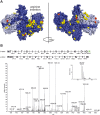Isolation and functional characterization of the novel Clostridium botulinum neurotoxin A8 subtype
- PMID: 25658638
- PMCID: PMC4320087
- DOI: 10.1371/journal.pone.0116381
Isolation and functional characterization of the novel Clostridium botulinum neurotoxin A8 subtype
Abstract
Botulism is a severe neurological disease caused by the complex family of botulinum neurotoxins (BoNT). Based on the different serotypes known today, a classification of serotype variants termed subtypes has been proposed according to sequence diversity and immunological properties. However, the relevance of BoNT subtypes is currently not well understood. Here we describe the isolation of a novel Clostridium botulinum strain from a food-borne botulism outbreak near Chemnitz, Germany. Comparison of its botulinum neurotoxin gene sequence with published sequences identified it to be a novel subtype within the BoNT/A serotype designated BoNT/A8. The neurotoxin gene is located within an ha-orfX+ cluster and showed highest homology to BoNT/A1, A2, A5, and A6. Unexpectedly, we found an arginine insertion located in the HC domain of the heavy chain, which is unique compared to all other BoNT/A subtypes known so far. Functional characterization revealed that the binding characteristics to its main neuronal protein receptor SV2C seemed unaffected, whereas binding to membrane-incorporated gangliosides was reduced in comparison to BoNT/A1. Moreover, we found significantly lower enzymatic activity of the natural, full-length neurotoxin and the recombinant light chain of BoNT/A8 compared to BoNT/A1 in different endopeptidase assays. Both reduced ganglioside binding and enzymatic activity may contribute to the considerably lower biological activity of BoNT/A8 as measured in a mouse phrenic nerve hemidiaphragm assay. Despite its reduced activity the novel BoNT/A8 subtype caused severe botulism in a 63-year-old male. To our knowledge, this is the first description and a comprehensive characterization of a novel BoNT/A subtype which combines genetic information on the neurotoxin gene cluster with an in-depth functional analysis using different technical approaches. Our results show that subtyping of BoNT is highly relevant and that understanding of the detailed toxin function might pave the way for the development of novel therapeutics and tailor-made antitoxins.
Conflict of interest statement
Figures







Similar articles
-
A Comprehensive Structural Analysis of Clostridium botulinum Neurotoxin A Cell-Binding Domain from Different Subtypes.Toxins (Basel). 2023 Jan 18;15(2):92. doi: 10.3390/toxins15020092. Toxins (Basel). 2023. PMID: 36828407 Free PMC article. Review.
-
Reoccurrence of botulinum neurotoxin subtype A3 inducing food-borne botulism, Slovakia, 2015.Euro Surveill. 2017 Aug 10;22(32):30591. doi: 10.2807/1560-7917.ES.2017.22.32.30591. Euro Surveill. 2017. PMID: 28816652 Free PMC article.
-
Characterization of the functional activity of botulinum neurotoxin subtype B6.Microbiol Immunol. 2017 Nov;61(11):482-489. doi: 10.1111/1348-0421.12540. Microbiol Immunol. 2017. PMID: 28898517
-
The Light Chain Defines the Duration of Action of Botulinum Toxin Serotype A Subtypes.mBio. 2018 Mar 27;9(2):e00089-18. doi: 10.1128/mBio.00089-18. mBio. 2018. PMID: 29588398 Free PMC article.
-
Botulinum neurotoxins: new questions arising from structural biology.Trends Biochem Sci. 2014 Nov;39(11):517-26. doi: 10.1016/j.tibs.2014.08.009. Epub 2014 Oct 1. Trends Biochem Sci. 2014. PMID: 25282537 Review.
Cited by
-
In vivo onset and duration of action varies for botulinum neurotoxin A subtypes 1-5.Toxicon. 2015 Dec 1;107(Pt A):37-42. doi: 10.1016/j.toxicon.2015.06.021. Epub 2015 Jun 27. Toxicon. 2015. PMID: 26130522 Free PMC article.
-
Historical Perspectives and Guidelines for Botulinum Neurotoxin Subtype Nomenclature.Toxins (Basel). 2017 Jan 18;9(1):38. doi: 10.3390/toxins9010038. Toxins (Basel). 2017. PMID: 28106761 Free PMC article. Review.
-
A Comprehensive Structural Analysis of Clostridium botulinum Neurotoxin A Cell-Binding Domain from Different Subtypes.Toxins (Basel). 2023 Jan 18;15(2):92. doi: 10.3390/toxins15020092. Toxins (Basel). 2023. PMID: 36828407 Free PMC article. Review.
-
Validation of a clinical assay for botulinum neurotoxins through mass spectrometric detection.J Clin Microbiol. 2024 Jun 12;62(6):e0162923. doi: 10.1128/jcm.01629-23. Epub 2024 Apr 30. J Clin Microbiol. 2024. PMID: 38687021 Free PMC article.
-
Resolution of Two Steps in Botulinum Neurotoxin Serotype A1 Light Chain Localization to the Intracellular Plasma Membrane.Int J Mol Sci. 2021 Oct 15;22(20):11115. doi: 10.3390/ijms222011115. Int J Mol Sci. 2021. PMID: 34681775 Free PMC article.
References
Publication types
MeSH terms
Substances
Associated data
- Actions
LinkOut - more resources
Full Text Sources
Other Literature Sources
Medical
Molecular Biology Databases

